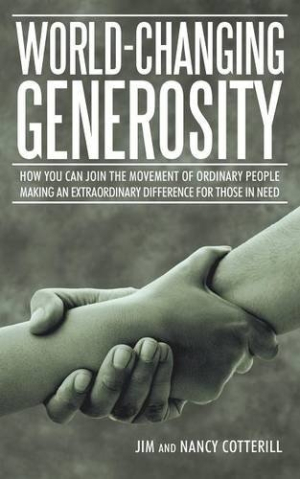World-Changing Generosity
How You Can Join the Movement of Ordinary People Making an Extraordinary Difference for Those in Need
A new guide to charitable work and global giving provides inspiration and guidance to those who want to live a more charitable life.
For those overwhelmed by depressing global news reports or who are facing disillusionment, authors Jim and Nancy Cotterill have an antidote. Their cogently written, passionately argued new book, World-Changing Generosity: How You Can Join the Movement of Ordinary People Making an Extraordinary Difference for Those in Need, works to reframe the way people think about charity and global strife*.*
Though the Cotterills had long been involved in philanthropic activities through their church and community, a life-changing incident more than a decade ago moved them to rededicate their lives to charitable work. The book details their subsequent engagement with nonprofits, corporations, and individuals, all designed to “help…people of differing convictions understand their own generous roots and to…convey their love to their fellow man through generosity.” Their new careers and advocacy, particularly their promotion of generosity as a way of life, fuel the work’s many inspirational accounts, wherein small acts of kindness produce ripple effects in the wider world.
Throughout the book, the Cotterills provide examples of how charitable acts benefit givers, too. Despite societal emphasis on consumerism, they note that recent scientific research shows that generous acts stimulate the brain’s pleasure centers. Subsequent feelings of well-being, they assert, open up opportunities for greater connections with others, and even an increased chance of personal prosperity.
World-Changing Generosity is brimming with positivity. The authors discuss the great progress made toward alleviating world hunger, poverty, disease, the lack of clean water, and other social and public health issues. They emphasize that even small contributions make a difference and empower both givers and recipients. The book is replete with examples of how average people can get involved in philanthropy, from direct action to financial contributions, including hints on researching the fiscal intricacies of charitable giving.
The tone of World-Changing Generosity is cogent and persuasive, avoiding any whiff of preachiness or sanctimony. Though the authors are devout Christians, they do not assert that any one religion or brand of philanthropy is superior to another. They succinctly analyze how the top ten religions and nonreligious movements in the United States view generosity. These sections serve as a mini-course on comparative religion, thoughtfully discussing the basic teachings of various traditions.
Some of the included photographs seem overly dramatized and staged. A naked white female slave is bound with ropes in one, while a homeless woman is passed out next to garbage cans in another. These ring somewhat false within the context of the overall message. Frequent offset quotes also become a distraction.
Its minor flaws aside, World-Changing Generosity is an important book that offers a positive alternative to consumer culture, and stands to counter apathy toward world problems. It provides invaluable inspiration and tips for getting more involved in tackling local and global issues, and should be appreciable among those looking to make a difference.
Reviewed by
Rachel Jagareski
Disclosure: This article is not an endorsement, but a review. The publisher of this book provided free copies of the book and paid a small fee to have their book reviewed by a professional reviewer. Foreword Reviews and Clarion Reviews make no guarantee that the publisher will receive a positive review. Foreword Magazine, Inc. is disclosing this in accordance with the Federal Trade Commission’s 16 CFR, Part 255.

